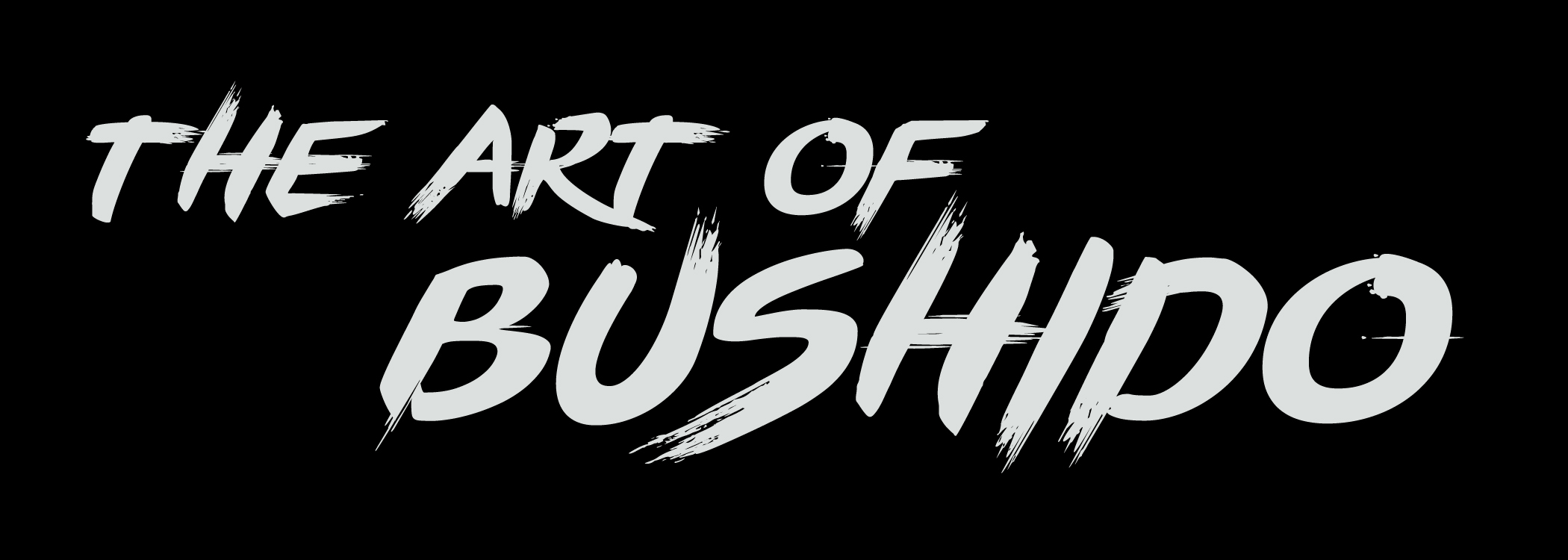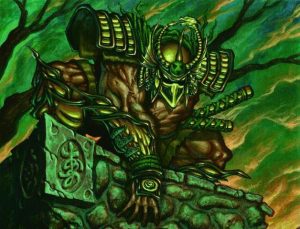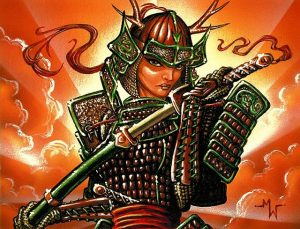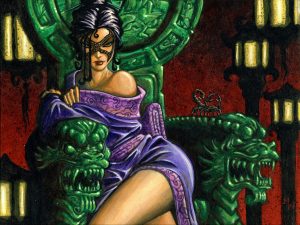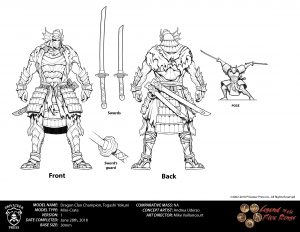For awhile I had wanted to interview Matt Wilson due to his old position with the CCG. Speaking with the original art director about the art of the game seemed like a no brainer. Other priorities and interests had me put it on the back burner but once Privateer Press announced their L5R minis line I knew I had to move it up. For those that don’t know, Matt is one of the founders of Privateer and the current Chief Creative Officer. So I spoke to him at this year’s GenCon about doing an interview and now here we are.
Who all was involved in the creation of the original design of the game and style guide? What in particular did they contribute?
First, a disclaimer: this is pretty ancient history at this point — about 22 years and counting, I think. So, I’ve probably forgotten more than I can remember, and some areas may be hazy. And any inaccuracies are unintentional, just due to the erosion of my memory!
As near as I can recall, I created the original style guide mostly on my own, though I’m sure I bounced ideas off of everyone available, so ultimately it’s a team effort. The main purpose of the style guide was to inform the artists we’d be contracting with what we wanted from the artwork. In order to do that, they needed some context for the world setting. My good friend and fellow collaborator, Matt Staroscik (who would later join the team as a developer, helping in pretty much every aspect of the product creation) had taken some Japanese language courses in college or high school, so I know I tapped him and I can remember going through one of his text books to come up with the name, ‘Rokugan’. meanwhile Dave Williams was working on the game design, and I’m sure we had conversations about how many factions to put in the game, number of characters, etc. But the original factions are mostly based on my own research into Japanese mythology and ancient, feudal Japan. I’ll add that this was my first foray into being an ‘art director’. I was faking it all the way, never having directed other artists nor worked with any professional art directors. And it was done in very little time…probably over a couple weeks. In today’s world, were I to approach it again, the style guide would be a several month process with multiple artists and writers involved to create a world bible that on its own could be a publishable product. But those were pioneering days!
The game design was spearheaded by Dave Williams. I had opportunities to participate in the development and play testing. And at one point early in the process, Matt Staroscik and I brought in a prototype card game called ‘Fortress’ that we had been working on for fun prior to being employed at AEG, and some aspects of that game — notably combat and the way followers attached to heroes — were influential on the design of L5R. And editor-in-chief, DJ Trindle, was also very involved in the development of the game and I remember him having a very keen instinct for the details of the design. With only a few people in the office, everything was very collaborative.
I’ve seen some of the initial style guide you had for the game but never a complete version. Do you recall any particular elements for each of the clans that didn’t make it into the final version or ended up changing after its creation?
Honestly, not really. We were working under such tight time constraints to hit the release target that we wanted that we didn’t have a lot of time to explore or be choosy. Most things that went into the style guide were ‘first drafts’, so to speak. I don’t remember any factions that didn’t make the cut, at least initially. And so much of the first two or three sets was made up as we’d go along, that it never made it into the style guide. I would go home from the office in the evenings and weekends and work on illustration for the game. I’d start with a bullet point on a list that said, ‘Dragon Samurai B’ or ‘Scorpion Shugenja A’ and then while I was working on the paintings, I’d start making up ideas for the backgrounds and abilities of the characters. I’d come back to the office with ‘Hitomi’ named after a favorite anime character, or a painting of a seductive courtesan, and I’d say to Dave that I thought it’d be interesting if she was an assassin instead of a shugenja and offer up some ideas for ability rules, and then John Wick would give the character a name and start working her into the stories. It was a really neat time where everyone’s creativity was just flowing and for better or for worse, just about anything that got thrown at the wall, stuck.
Were there any artists you knew you wanted to work with from the start? Anyone you couldn’t get due to time constraints or other discrepancies?
There were many artists that I wanted to be able to work with on the original Legend of the Five Rings card set. Most of them were artists whose work I knew from Magic: the Gathering. I won’t remember everyone at this point, but a few names that spring to mind are Brian Snoddy, of course, who in particular had an unparalleled expertise with armor from feudal Japan. There was Ron Spencer, Randy Elliott, Rob Alexander…lots of amazing talents. I’m sure there were some people who were unavailable but I can’t recall any of them at this point, just the folks who ended up contributing and making that first set possible.
Up through which set were you art director and/or artist on?
I had to do a little research, and still I’m not 100% sure. I am pretty certain that I art directed up through Crimson & Jade. I think it came out just a little after I had moved on to Wizards of the Coast, so I can’t recall if I was there until the set finished or if I checked out a little early. And then I did a couple illustrations for Time of the Void. Looking back, it’s more than I recalled! I think it was well over 1,300 cards in a fairly short period of time, not to mention some of the other projects we had going on. Very busy times!
Almost all of the personalities of L5R were unique, even if there cards didn’t denote it mechanically, and often tied close to the story. How much of those characters design was coming from you and how much from the story aspect of things? Additionally did the artists ever make a change that you then rolled into the story?
The chronology of how things came into existence was a little different than how things might be approached by a team with experience or resources. We were all first-timers at this, we were few, and we were largely making everything up as we went along.
I created the background for the world and the overarching conflict — the clans vying for Rokugan’s throne. After that, art descriptions were created and sent out, along with the early bible, to artists. We knew the game would be heavily influenced by some sort of narrative, which started to emerge once flavor text started getting written for the cards. But the real story started well after artwork started getting commissioned.
Particularly in those early days of the first set, art direction was pretty loose and the artists had a lot of latitude. We were paying next to nothing so I didn’t feel like we had a lot of leverage to lean hard on the artists or put them through a lot of revisions. So there is somewhat of a lack of consistency in styles and approach. Some of the work was very fantastic while other pieces were heavily inspired by historical elements. However, almost none of the pieces that were commissioned in the Imperial Edition were named characters when they went to the artists. I had a list of slots to fill that looked like, ‘Crab Samurai A’, ‘Pheonix Champion’ and ‘Scorpion Shugenja B’. And what we got back from the artists was usually what inspired the character, particularly if it was a really fantastic looking character.
The reason I have quite a few of the high profile characters in those early sets is because, as I mentioned previously, I’d go home in the evening to work on ‘Crab Samurai A’ and a few days later would come back with some dude with a mechanical crab claw, which we’d then give a name and make rules around. I didn’t set out to paint Hida Yakamo, but once I came back with him gears started turning on who he was, how he got his crab claw, etc.
And this happened with a lot of pieces. We’d get a painting in that might have been for something really mundane, like harvesting grain, and then it would have such a cool character in it, that we’d swap it for another piece where the character didn’t seem to fit as well, and then we’d alter the card concept of ‘harvesting wheat’ to work with the art he had. The game developed into something very character-focused, so priority in the artwork was usually given to whatever characters were the most inspiring. And being a small team, we were very fluid and adaptable, so when an artist went in an unexpected direction or gave us something that sparked our imaginations, we would certainly adjust accordingly.
Having been the original creator of some of these characters did you have any attachment to what happened to them in the story? What about when you would see them illustrated by another artist?
Doing experienced versions of the characters was something that I introduced to Legend of the Five Rings, in large part because I wanted a reason to revisit them in the artwork (Incidentally, a storytelling mechanism that I also brought over to WARMACHINE several years later). Bayushi Kachiko and Togashi Yokuni were always my two favorites and I took every opportunity to paint them that I could. Putting a character arc into the game reinforced the need for the story and partly informed where it would go. As I was developing as an artist I started to get a bit experimental, though less stylistically and more about trying to be more economical with my time and produce more work. One piece I did had Yokuni perched on a wall in a garden while Kachiko sat below him. The painting was composed so we could crop two character images out of it, so it never appeared in the game as that scene, but I did produce a print of it intact and it was one of my favorite pieces that I did for the game. There was no story driving that image, it was just something I was inspired to do, but it ended up forcing a connection in the story between those two characters. As I mentioned, the real story didn’t start until well after the game was underway and even the first set was produced, so it was catching up to where we were in the rules and artwork, connecting the dots between characters that were created without a true sense of where they belonged, other than their clan identity. I’m not even sure the story was particularly developed before I ended my tenure on L5R, so I don’t think I really followed it closely. For me, the characters were more archetypes. I knew there were certain dynamics and relationships between characters, quite a few such connections I proposed or ‘forced’ (like with the example above), but I never really followed where the story took them.
Seeing other artists reinterpret characters that I have created has always been exciting to me. It’s something I’ve enjoyed now for almost 25 years. As the lead concept artist for Magic: the Gathering as well as having concepted literally hundreds of different characters for WARMACHINE and HORDES, other artists have produced more final illustrations of my character designs than I have. It’s also fun to see them reinterpreted as miniatures sculptures! Legend of the Five Rings, in particular, matured greatly over the couple of decades since I first started it. In the beginning, it was a very rushed project and I was a fledgling artist and art director, learning my craft on the job. As other art directors succeeded me, the vision for the property got tighter and more cohesive, and the quality of artwork became more consistent. It’s been interesting to see how things have evolved. Most recently, in working with Fantasy Flight Games on Privateer’s upcoming Legend of the Five Rings MiniCrate line, I’ve gotten to see the most recent interpretations of some of the iconic characters from the original game, several of which I had created. The artists FFG has worked with are all top notch and they’ve done a beautiful job.
Are there any of those characters you’d like to revisit now?
If the opportunity came up, I’d love to revisit Yokuni and Kachiko. They were definitely my favorites and I loved playing them off each other. In a fashion, I did get to revisit Yokuni with this new L5R MiniCrate miniatures line. I didn’t do the actual concept art for it, but I did offer a bit of input in the revision and it was great to see and work with the character again.
How did it feel to be involved with the design of a character you created and illustrated about 20 years ago? Were you designing vicariously through Andrea Uderzo?
It was a warm reunion to be back in contact with Togashi Yokuni. He’s changed over the years, for sure. But we wanted first and foremost to stay true to the new vision that Fantasy Flight has created for the L5R living card game, so the latest rendition of Yokuni is what primarily informed the design of the new miniature.
Were there any illustrations you did back in the day that didn’t make it into a final product or was everything used in some way or another?
There were a few pieces that I did for promo posters that didn’t go on cards. The very first image I ever painted for L5R was a sort of proof of concept. It was Yokuni posed amidst a carnage-strewn battlefield. I think it was only ever used on an announcement flyer. Later, I did another painting of Yokuni, again posed over a pile of his victims (are you seeing the theme?) and we used that on a poster and then later it was used as the cover for the Beiden Pass box set. I did one or two other posters that I don’t think we used on the cards. And then I also did a couple covers for the RPG that didn’t get used on cards. Nothing that I recall ever ended up on the cutting room floor, so to speak, but certainly some should have! I was working very quickly back then and some of my own paintings were more successful than others.
Now with your roughly 25 years of experience since helming the AD for L5R, is there anything you wish you’d done differently?
The pace back then was breakneck. Looking back, I wish I could have slowed down with some of the artwork and spent more time on it. For me it was a learning time. I dropped out of college after a year and a half so I had almost no formal art training, it was all book learning and self-study and this is before you could find a tutorial for anything and everything on the internet. Consequently, I have a lot of artwork out there that I would not necessarily want to be judged by.
I also wish that initial style guide had been tighter. Again, so much if it was ‘make it up as we go along,’ that I’m lucky much of the artwork held together at all in those first couple sets. But eventually we found more cohesion in the artwork.
Is there anything else you’d like to add?
Getting to cut my professional teeth on Legend of the Five Rings was an experience I’ll always cherish. It taught me lessons that I still use today about publishing, art direction, team coordination, world building and game design. Many of the things that I brought to L5R found their way into WARMACHINE, years later, like the evolving characters or just the approach of telling an evolving story through an ongoing game experience. I’m amazed at the run L5R had — twenty years! I’m proud to have been part of the team that brought it to life and I look forward to seeing where it goes and what it becomes in the next ten and twenty years!
